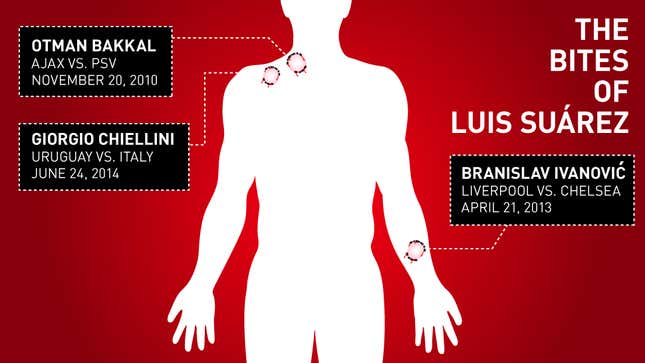
I was sitting in my office yesterday, not watching the World Cup, when I came across a tweet by my friend: "It's kind of fun that the third-best player in the world is just definitely insane," it said. A moment later, I was watching Luis Suárez, Uruguay's star forward, take a bite out of Italian defender Giorgio Chiellini's left shoulder. It was, remarkably, the third time Suárez has done such a thing. (His prior chomps occurred while playing for the Dutch club Ajax and the English side Liverpool.)
To many, this behavior is hilarious. Even Evander Holyfield found it funny. But my thoughts turned elsewhere. I'm an infectious disease doctor and I couldn't help but think about the potential dangers when one deranged human bites into the sweaty flesh of another. In a lot of ways, it would be safer if Suárez's thing were hauling off and kicking his opponents in the nuts.
When one human bites another, bacteria from the mouth of the biter can be transferred to the skin of the victim. The pathogens that live in the mouth include common Staph and Streptococcus species, as well more obscure, yet potentially lethal bacteria like Eikenella, Fusobacterium, Peptostreptococcus, and Prevotella. You might not have heard of Eikenella, but at our hospital we see it quite frequently, typically as the causative agent of endocarditis, a potentially life-threatening infection of the heart. The bacteria can live harmlessly in the mouth, but if enough of it gets into the blood stream, it can wreak havoc. There's a good chance Luis Suárez has Eikenella living in his mouth—most of us do.
But wait, there's more: Syphilis can also be transmitted via biting. The one case I know of occurred when a prostitute bit a 47-year-old man in the right nipple during sex. The nipple bled profusely, eventually became ulcerated, and failed to respond to several rounds of antibiotics. It was more than a month before doctors figured out it was syphilis. Not that anyone involved is known to be carrying around an STI—but would you want to explain how you caught syphilis from Luis Suárez?
There's a laundry list of diseases a bite victim could potentially contract from a biting incident. Viral pathogens, including hepatitis B and C, HIV, and herpes simplex virus, are all transmissible by human bites.
Obviously most bite wounds don't take place on the soccer pitch. When I see them in my practice, it's usually the result of one of three processes:
- A bite to the face, breast, or genitals during sex (these are occasionally referred to as "love nips")
- Nail-biting or thumb-sucking
- Fistfights
A bite wound from a fistfight is the type I encounter most commonly. (Biting wasn't the intention, but that's what we call it when a clenched fist meets a row of teeth.) It's perhaps the most dangerous type of bite wound because involvement of the hand portends a high risk for bone infection (osteomyelitis) or joint infection (septic arthritis), which can necessitate weeks, if not months, of intravenous antibiotics. And it can leave someone permanently debilitated if it's not caught in time. In the area where Chiellini was bitten, my primary concern would be nerve damage. The brachial plexus – which includes the axillary, suprascapular, musculocutaneous, and long thoracic nerve – all reside in the general area where Suarez mashed his teeth (although the bite probably didn't go deep enough to cause severe damage).
Obviously, not all bites cause infection. Some victims have a strong enough immune system to dispense of any bacteria that might enter the skin or blood stream before it takes a stronghold in the body. As clinicians, the symptoms we look for that suggest infection include fever, redness, swelling, tenderness, and weeping pus from the bite site. (We don't yet know the status of Chiellini's wound.) Regardless of whether it's infected or not, all bite wounds should be washed out, and visible debris—teeth, hair, dirt, etc.—should be removed. Surgical evaluation is occasionally necessary to evaluate nerve and muscular function and the extent of injury to tendons, bones, and joints, but given the location of yesterday's bite—it happened in a fleshy part of the shoulder—it's unclear if Chiellini's will need to see a surgeon. I kinda doubt it.
In general, bite wounds shouldn't be bandaged; they should be left open, and after a few days closure can be performed with sutures if the injury isn't closing on its own. (Facial bite wounds are a special exception; closure by a plastic surgeon is preferable to avoid scarring). In general, I recommend antibiotics to just about anyone who suffers a human bite that pierces the dermis—the layer of skin between the epidermis and subcutaneous tissues—regardless of the overall appearance of the injury.
Unfortunately, there aren't any good comparative antibiotic trials for treatment of human bite infections, so I generally pick a drug based on its ability to kill the most common bacteria in the mouth. It's a bit of a guessing game, and I often go with a derivative of penicillin—an antibiotic like Augmentin or Unasyn—and, potentially, a second antibiotic like Flagyl. And depending on his vaccination status, he might also need a tetanus booster. This can all get rather expensive rather quickly.
In his preposterous post-match interview, Suárez said, "There are things that happen on the pitch and you should not make such a big deal out of them." It would be disturbing if this was an isolated incident, but Suarez continues to put opponents at a very real risk for significant injury, and he clearly doesn't care. Thankfully, FIFA has opened disciplinary proceedings against him. When they make their ruling, they should take into account just how dangerous his behavior is. Let's hope they come down hard against the Uruguayan Dracula.
Matt McCarthy is board-certified in internal medicine. You can follow him on Twitter here.
Image by Jim Cooke